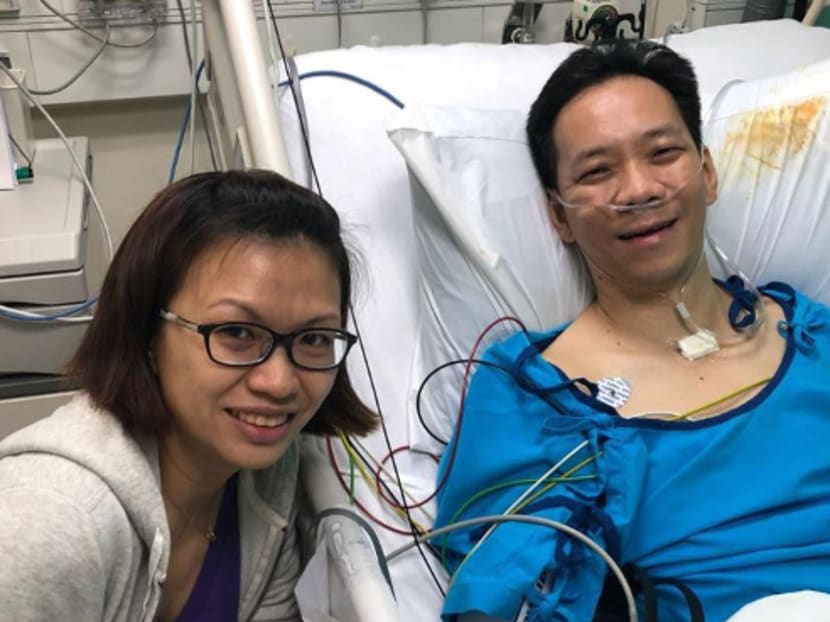His only symptom was heel pain. It turned out to be stage 4 lung cancer
SINGAPORE — Music teacher Simon Loy woke up with heel pain one morning in 2018. He thought it was a relapse of sports-related pain that he used to experience after clocking long-distance races

After failing to quit smoking several times due to his work environment, Mr Simon Loy (pictured) stubbed out for good after he stopped playing in bands and became a full-time music teacher in his 30s.
- A bout of heel pain turned out to be stage 4 lung cancer for a man in his 40s
- The former Cantopop band musician quit heavy smoking when he became a father
- However, that was likely too late
- After chemotherapy and immunotherapy, the cancer is considered to be in remission
- Treatment was costly and he said getting adequate insurance coverage is important for anyone
SINGAPORE — Music teacher Simon Loy woke up with heel pain one morning in 2018.
He thought it was a relapse of sports-related pain that he used to experience after clocking long-distance races.
When the pain worsened over the weeks, his left calf started to swell. Walking became excruciatingly painful for the former avid runner.
What he did not know, was that cancer cells had been growing and spreading in his body.
The leg swelling turned out to be a blood clot in his left leg. Subsequent investigations revealed a 5cm tumour in the lungs. Cancer was also found in his neck.
“Up until then, I had no major issues with my health and had never been hospitalised,” he said. “I had no respiratory symptoms either. If it hadn’t been for the heel pain, I would never have known I had stage 4 lung cancer.”
Now 47 years old, he is the father of three children aged 17, 20 and 21.
Lung cancer usually shows up as a persistent cough, where the person coughs up blood and has chest pains that worsen with deep breathing and coughing, shortness of breath and voice hoarseness.
However, it is estimated that up to one in five people with cancer — not just lung cancer — may develop blood clots.
Dr Kevin Tay, a senior consultant medical oncologist at OncoCare Cancer Centre who is treating Mr Loy, said that these blood clots most commonly occur in the veins of the legs and lungs.
The risk is greater in patients with advanced cancer.
Dr Tay said: “Cancer cells are capable of activating the clotting pathways and other pro-thrombotic (coagulation) properties of host cells, making the blood 'stickier' and hence easier to form clots. Furthermore, abnormal growth and enlargement of the cancer mass may press on major blood vessels in the body, and therefore impede (blood) flow, resulting in development of blood clots.”
Patients with advanced cancer may also be more fatigued and less mobile, which also puts them at higher risk of developing blood clots due to poor blood circulation, he added.
HE JUST WANTED TO DIE FAST
When Mr Loy first learnt he had lung cancer, all he wanted to do was to give up and die without a fight.
Having witnessed how his late mother battled cancer three times in a span of 15 years, he felt fearful and hopeless.
His mother, who worked as a cleaner, had breast cancer twice and stomach cancer. She died from complications following surgery to treat stomach cancer.
He recalled the immense physical and financial toll the cancer treatments took on her and the family.
Reading up about his condition online further heightened his sense of impending doom. He even made financial plans so that his wife and their children, aged around 14, 18 and 19 at the time, could cope when he was no longer around.
“I was devastated after finding out (online) that the survival rate was merely 5 per cent while the remaining lifespan of a stage-4 patient was not more than 200 days. It was a scary and emotional time for me,” Mr Loy said.
“I told the doctor, if I was going to have only 200 days to live, why bother treating me? Just give me painkillers so I can enjoy my remaining days. Just let me be.”
More than 200 days have passed since Mr Loy’s diagnosis in June 2018.
“Dr Tay dispelled my prior misconceptions on survival rate, explaining that the statistics I had found online also included patients who either refused or had no access to treatment,” he said.

After undergoing chemotherapy and immunotherapy, the disease is now considered to be in remission. This means that the cancer is not detected from scans or blood test.
He said: “At the time, I didn’t think I would make it to see 2019. What changed my mindset (to undergo treatment) was the support from children and wife Adelene, who said she would walk the journey with me.
“I was so afraid to lose my family and worried about what would happen to them if I were to pass on.”
HEAVY SMOKING: QUITTING TOO LATE
Lung cancer is one of the most common cancers and causes of cancer deaths in Singapore. Mr Loy was diagnosed with non-small-cell lung cancer, which accounts for up to 90 per cent of all lung cancer cases.
Dr Tay, his oncologist, said that smoking is the top risk factor for lung cancer and this includes the use of other tobacco products such as cigars or pipes.
People who smoke are 15 to 30 times more likely to get lung cancer than those who do not smoke, Dr Tay said. The risk increases each year a person smokes and the number of cigarettes he or she lights up each day.
Lighting up 30 to 40 sticks of cigarettes every day used to be the norm for Mr Loy. That was during the height of his music career when he was a guitarist performing with various bands here that was into the Cantopop scene in the 1990s.
“Back then, there was no smoking ban in clubs. I was also in an environment where it was normal to be breathing in a lot of smoke,” he said.

After failing to quit smoking several times due to his work environment, Mr Loy stubbed out for good after he stopped playing in bands and became a full-time music teacher in his 30s.
“At the time, my children were growing up. The youngest was only around two years old. I didn’t want to be a bad example to them,” he said.
While quitting smoking can lower the risk of lung cancer, an ex-smoker’s risk remains higher than those who have never smoked, Dr Tay said.
Having said that, a study showed that those who quit before 35 years old had similar survival outcomes than non-smokers, he added.
Besides a family history of lung cancer, secondhand smoke increases the risk of lung cancer, too — as well as exposure to air pollution and other chemicals such as chromium and diesel exhaust.
Dr Tay said that agencies such as the United States Environmental Protection Agency and the International Agency for Research on Cancer have classified second-hand smoke as a known human cancer-causing agent.
There are studies to show that non-smokers who are exposed to second-hand smoke at home or at work increase their risk of lung cancer by 20 to 30 per cent. Research has also shown that, as with active smoking, the risk of developing lung cancer increases when the duration is longer and the level of exposure to second-hand smoke is higher.
THE TREATMENT
For Mr Loy, the cancer was treated with immunotherapy called pembrolizumab as well as chemotherapy.
This required him to complete six cycles of chemotherapy across five months. On top of that, he had to undergo immunotherapy, a treatment that enhances the patient’s immune response against cancer cells, every three weeks.
Dr Tay said that cancer treatments have progressed beyond conventional chemotherapy, and there are many immunotherapy drugs approved for use in lung cancer patients.
It is now known that there are multiple genetic subtypes in lung cancer, based on the different gene mutations, such as the EGFR and ALK genes.
Newer therapies work on targeting those gene mutations. For example, a lung patient with EGFR gene mutation will be treated with an oral drug that targets this gene, Dr Tay said.
While Mr Loy’s cancer did not express any of the commonly associated lung cancer genetic mutations, it tested positive for a protein known as PDL-1.
“Individuals with high expression of this PDL-1 protein on their tumour respond well to immunotherapy, making it an effective treatment option,” Dr Tay said.
“With newer treatments, the median overall survival for patients with lung cancer that has spread is about two to three years, compared to about one year when lung cancer is treated with conventional chemotherapy alone.”
At the World Conference on Lung Cancer in January this year, four-year data from a third-phase trial showed that 80 per cent of patients who completed two years of treatment with pembrolizumab in combination with chemotherapy were alive after four years of follow-up.
These are patients with metastatic non-squamous non-small cell lung cancer who do not harbour certain mutations that drive the cancer.
After his mother’s experience with cancer, Mr Loy bought an insurance plan that “covers everything”. He is now thankful for it because he estimates that the treatments would have cost around S$1 million from the time he was diagnosed.
Emphasising the importance of getting adequate insurance coverage because cancer treatment can be costly, Mr Loy said: “My mum had no insurance coverage at all and not much savings. I saw how she struggled.”
Dr Tay said that other than private insurance, the Central Provident Fund’s MediSave and MediShield Life insurance plans provide financial coverage for cancer treatments such as chemotherapy, radiotherapy and immunotherapy.
However, the amount of coverage would vary according to the insurance plan that the individual has.
While on treatment, Mr Loy experienced side effects such as itchy skin, rashes and severe lethargy but continued working because he was worried about affecting the family’s finances. His wife, 45, also works as a music teacher.
“The lethargy got really bad sometimes but somehow, I made it through. The doctor told me to rest for half a year but I was thinking, how will my kids be fed if I don’t work?”
CHANGES TO LIFESTYLE AND MINDSET
After his diagnosis, Mr Loy made drastic changes to his diet and the entire family started eating clean. Meals prepared are low on salt, sugar and oil. Processed foods were cut out.
“I started appreciating food in its original form. My children are not the verbally expressive types but they supported me in their own ways, like going on this bland diet with me,” he said.
An atheist before his diagnosis, Mr Loy now finds hope and solace from his spiritual life. He was touched when members from his wife’s church prayed for him.
He hopes that cancer will “stay out of the way” and not affect anyone else he knows and loves. He would like to see all of his children grow up and be a part of their future.
Mr Loy has made peace with the fact that the cancer may recur. “I am ready to go. But whatever comes, cancer or not, I will take it as it is. I will fight again. I won’t give up.”









